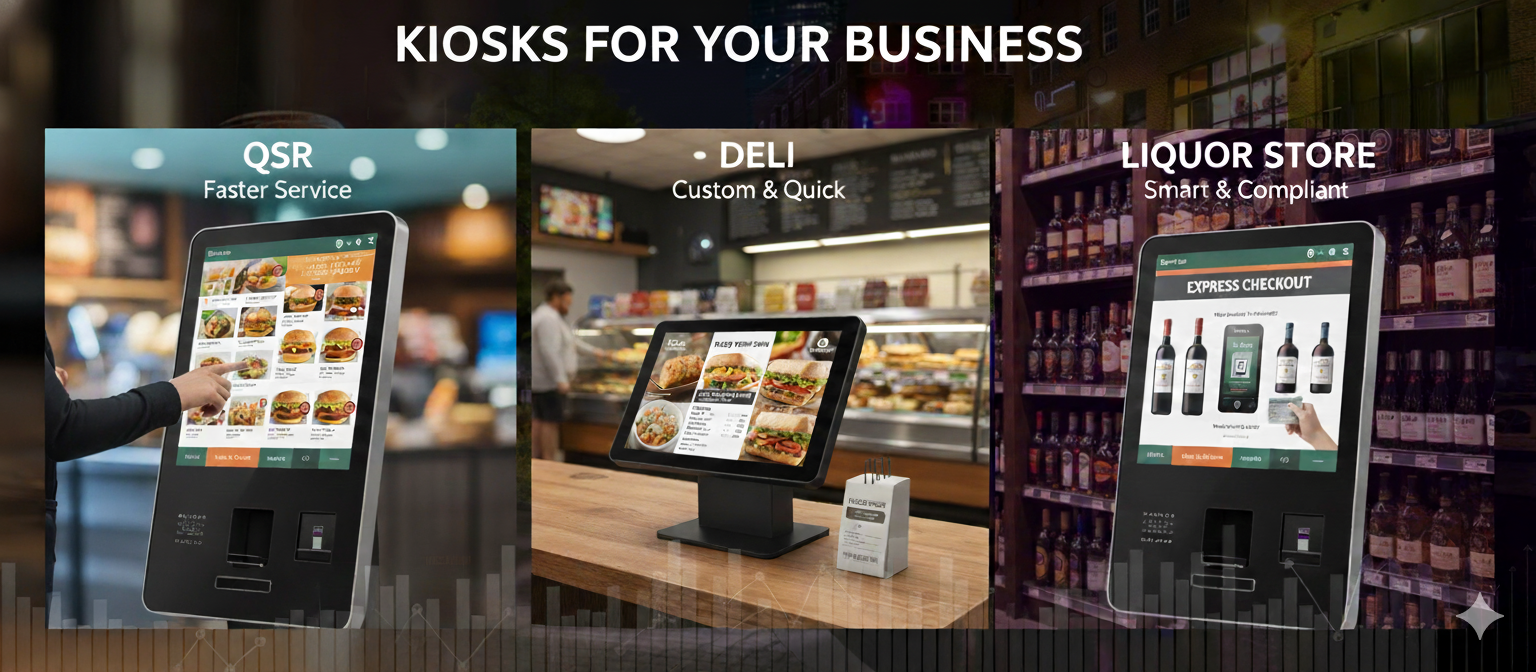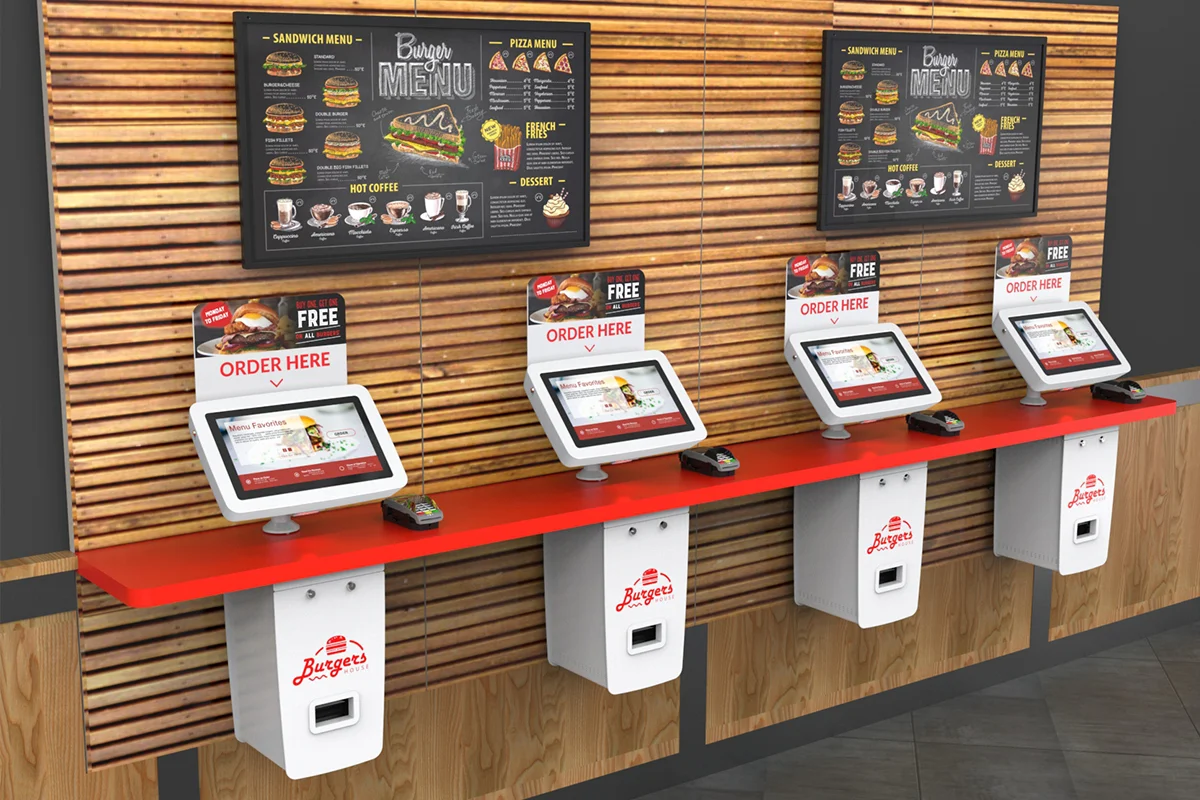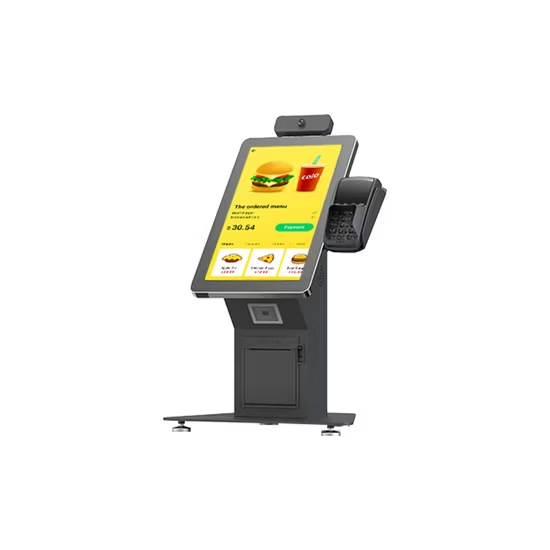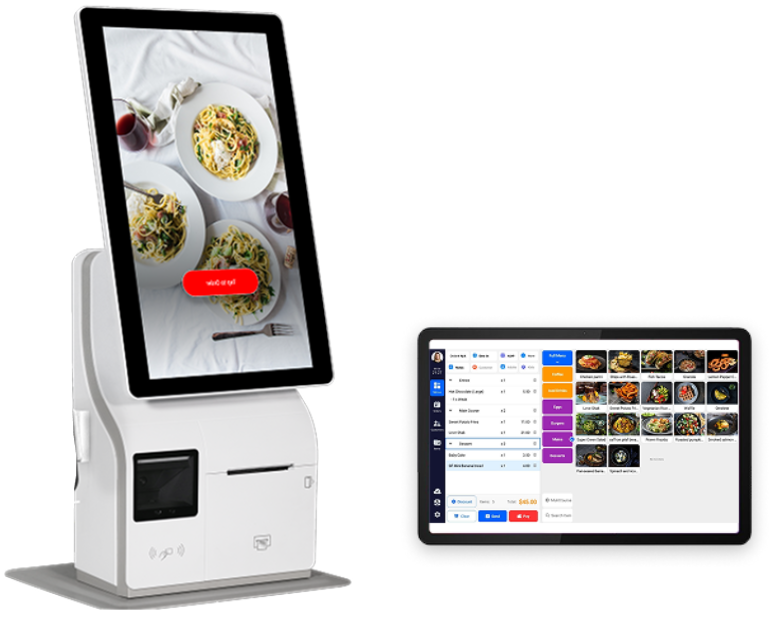Kiosks for Your QSR, Deli, or Liquor Store: Types, Forms, Costs & How to Pick the Best One

The U.S. kiosk market is growing at double-digit speed. Walk into any McDonald’s today and you’ll see one constant: customers clustered around self-order kiosks — tapping, customizing, paying, and walking away with a smooth, error-free, cashier-free ordering experience. In fact, 61% diners prefer a self-service kiosk over the traditional billing at the counter.
Globally, McDonald’s kiosks proof-tested a simple truth: Kiosks increase revenue, reduce wait times, and run without extra staff or operational complexity.
But kiosks aren’t just for global giants anymore. Today, small businesses (QSRs, delis, and even liquor stores) are adopting kiosks to speed up orders, reduce queue pressure, improve accuracy, and give customers the “control and convenience” they increasingly expect.
👉 See Also: Why Your Restaurant Needs a Self-order Kiosk
In this blog post, we help you choose the right kiosk type and form factor for your business — plus costs, deployment tips, and what to avoid.
How Kiosks Drive Higher Revenue With Lower Operational Load
Before we dive into kiosk types, here’s the business logic that makes them a must-have today:
1. Higher ticket sizes: Self-order customers consistently spend more — +12% to +20% higher average ticket value in QSR settings—because kiosks gently promote add-ons, combos, and upgrades.
👉 Must Read: How Self-ordering Kiosks Boost Sales in 2025
2. Faster throughput: During peak hours, kiosks pull customers out of the main line, helping you serve more orders with the same team.
3. Lower staffing pressure: Instead of having 2–3 staff take orders, your team can shift to fulfilment, prep, or customer assistance.
4. Fewer errors, better experience: Customers see all customization options clearly. No misheard orders. No rush. Higher satisfaction. This is why kiosks have exploded beyond QSRs — into delis, convenience stores, and liquor stores.
Types & Forms of Kiosks: What Works Best for QSRs, Delis, and Liquor Stores
Below is the definitive breakdown of kiosk types, real-world use cases, cost ranges, deployment tips, and limitations — customized for your vertical.
QSR Kiosks: Which Type Fits Your Restaurant?
1. Table-top Kiosks (QSR)

Why It Works?
- Table-top kiosks sit on counters, islands, or pickup stations, letting customers order or customize without waiting for staff. Perfect for lunch and dinner rush when throughput matters.
- Studies show self-service kiosks significantly boost perceived convenience—and increase spend because customers feel more in control.
- This format fits QSRs with limited floor space or a goal to increase digital ordering without redesigning layout.
Deployment Tips
- Place near the queue or right after the order-entry lane.
- Must include NFC/EMV payments and real-time sync with POS.
- UI must be lightning-fast—slow screens = kiosk abandonment.
- Use upsell logic (“Add fries + drink for $2?”).
Limitations
- Lower visibility than floor units.
- Needs regular cleaning and calibration.
Cost Range: $1,800–$3,000
Best For: Small–medium QSRs, franchise operators, entry-level kiosk adoption.
2. Wall-mount Kiosks (QSR)

Why It Works
- Wall-mounted kiosks turn your sidewalls into ordering lanes. They’re ideal in tight QSR footprints, allowing customers to pre-order, pay, and move directly into pickup flow.
- Large chains frequently use them to reduce queue times and eliminate bottlenecks.
Deployment Tips
- Mount 45–50 inches from the floor for accessibility.
- Position near entrances or along queue walls with clear signage.
- Ensure menu updates and promotions push automatically through POS.
Limitations
- Installation requires power/data setup.
- Hard to reposition once mounted.
Cost Range: $2,000–$4,000
Best For: High-traffic, narrow-layout QSRs.
3. Floor-standing Kiosks (QSR)

Why It Works
- Floor kiosks are the flagship of QSR self-ordering. These tall 27″–32″ displays act as self-contained order stations, handling full menu browsing, customization, payments, and pickup-ticket printing.
- They deliver the highest visibility and strongest conversion—making them perfect for busy QSRs, malls, or food courts.
Deployment Tips
- Place at the start of the queue or in a dedicated self-order lane.
- Use large intuitive screens for maximum speed.
- Track orders/hour, ATV lift, and queue reduction via POS analytics.
Limitations
- Take up more space.
- Higher installation and hardware cost.
Cost Range: $2,200–$6,000
Best For: High-volume QSRs, multi-unit brands, drive-thru lobbies.
Deli & Liquor Store Kiosks: What Actually Works?
These verticals have unique workflows—fast grab-and-go orders (delis) and compliance-heavy checkout (liquor). Here are the best fits.
Table-top / Counter Kiosks (Delis & Liquor)

Why It Works
For delis:
- Customers build sandwiches/salads/combos
- Pay instantly
- Pick up from a dedicated window
For liquor stores:
- Customers reserve bottles
- Select bundles
- Use express self-checkout (with ID verification)
- A small footprint means minimal disruption. POS sync ensures real-time inventory accuracy.
Deployment Tips
- Add receipt or QR printing for pickup.
- Liquor: enable ID scan or staff override workflow.
- Use signage: “Order Your Sandwich Here” / “Reserve Premium Bottles.”
Limitations
- Takes counter space.
- Compliance is mandatory for alcohol.
Cost Range: $1,500–$3,500
Best For: Small delis and boutique or mid-size liquor stores.
5. Floor Or Wall-Mount Kiosks (Delis & Liquor Stores)

Why It Works
For liquor stores:
- Floor kiosks near premium shelves encourage customers to explore bundles, limited editions, or quick checkouts.
- Perfect for after-hours or staff-light shifts.
For delis:
- Wall units near coolers encourage impulse “grab-and-pay” orders.
- Helps reduce front-counter congestion.
Deployment Tips
- Liquor: ensure inventory sync; flag age-restricted SKUs.
- Delis: place kiosks near high-traffic snack/drink zones.
- Use POS analytics to identify high-performing kiosk spots.
Limitations
- Age verification must be tight (kiosks can be compliance weak points).
- Signage and staff support improve adoption.
Cost Range: $2,500–$6,000
Best For: Busy delis, medium-to-large liquor stores, impulse-heavy layouts.
Comparison Table: Kiosk Types, Best Use Cases & Costs
How to Choose the Right Kiosk for Your Business
Use this simple decision flow:
1. How big is your space?
Small footprint → table-top
Medium footprint → wall-mount
Large/traffic-heavy → floor-standing
2. What is your primary bottleneck?
Queue congestion → floor-standing or wall-mount QSR kiosks
Lunch rush → table-top deli kiosks
Express alcohol checkout → counter self-checkout with ID flow
3. How complex is your menu/catalog?
Highly customizable meals → floor or wall kiosks
Simple combos or bundles → table-top
4. What’s your budget?
Entry level: table-top
Mid-tier: wall-mount
Premium: floor-standing
The OneHubPOS Advantage: Kiosks That Actually Make Store Ops Easier
Unlike legacy POS providers, OneHubPOS is Android-powered, cloud-native, and built for real-world SMB speed. That means:
- Instant menu changes across all kiosks
- Real-time inventory sync
- Processor-agnostic payments
- Auto-updates without downtime
- Built-in offline mode
- Multi-location kiosk + POS management
- Reliable Android hardware
- Rapid deployment (just plug, mount, and go)
Kiosks are no longer luxuries — they’re revenue machines. Whether you run a busy QSR, a neighborhood deli, or a growing liquor store, the right kiosk setup can unlock faster lines, happier customers, and more profitable orders.
Ready to find the perfect kiosk setup for your store?
Let’s help you map the right hardware, cost, and configuration based on your space and sales goals. Book your free 30-minute demo instantly to get a solution that suits your business needs the best.
Sahana is a seasoned GTM leader with a passion for building startups. She excels in crafting GTM strategies for tech products, driving revenue growth.


